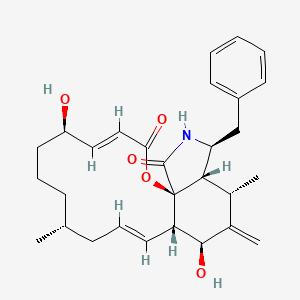| Tallon I et al. |
Cell cycle dependent aneuploidy induction by X-rays in vitro in human lymphocytes. |
1998 |
Microsc. Res. Tech. |
pmid:9527045
|
| Arioka M et al. |
Multidrug resistance phenotype conferred by overexpressing bfr2+/pad1+/sks1+ or pap1+ genes and mediated by bfr1+ gene product, a structural and functional homologue of P-glycoprotein in Schizosaccharomyces pombe. |
1998 |
Biosci. Biotechnol. Biochem. |
pmid:9532803
|
| Battistella-Patterson AS et al. |
Effect of disruption of the cytoskeleton on smooth muscle contraction. |
1997 |
Can. J. Physiol. Pharmacol. |
pmid:9534938
|
| O'Brien TG et al. |
The effect of colchicine on the induction of ornithine decarboxylase by 12-O-tetradecanoyl-phorbol-13-acetate. |
1976 |
Cancer Res. |
pmid:954002
|
| Kopprasch S et al. |
Hypochlorite-modified low-density lipoprotein stimulates human polymorphonuclear leukocytes for enhanced production of reactive oxygen metabolites, enzyme secretion, and adhesion to endothelial cells. |
1998 |
Atherosclerosis |
pmid:9543103
|
| Elbim C et al. |
Heterogeneity in Lewis-X and sialyl-Lewis-X antigen expression on monocytes in whole blood: relation to stimulus-induced oxidative burst. |
1998 |
Am. J. Pathol. |
pmid:9546369
|
| Granholm NH and Brenner GM |
Effects of cytochalasin B (CB) on the morula-to-blastocyst transformation and trophoblast outgrowth in the early mouse embryo. |
1976 |
Exp. Cell Res. |
pmid:954859
|
| Nishizaki T and Matsuoka T |
Low glucose enhances Na+/glucose transport in bovine brain artery endothelial cells. |
1998 |
Stroke |
pmid:9550521
|
| Love DC et al. |
Leishmania amazonensis: the phagocytosis of amastigotes by macrophages. |
1998 |
Exp. Parasitol. |
pmid:9562419
|
| Takeshita H et al. |
Actin organization associated with the expression of multidrug resistant phenotype in osteosarcoma cells and the effect of actin depolymerization on drug resistance. |
1998 |
Cancer Lett. |
pmid:9563651
|
| Kim NH et al. |
Blastocoele formation and cell allocation to the inner cell mass and trophectoderm in haploid and diploid pig parthenotes developing in vitro. |
1997 |
Zygote |
pmid:9563684
|
| Xie B et al. |
Fibronectin-mediated cell adhesion is required for induction of 92-kDa type IV collagenase/gelatinase (MMP-9) gene expression during macrophage differentiation. The signaling role of protein kinase C-beta. |
1998 |
J. Biol. Chem. |
pmid:9565574
|
| Haneskog L et al. |
Biomembrane affinity chromatographic analysis of inhibitor binding to the human red cell nucleoside transporter in immobilized cells, vesicles and proteoliposomes. |
1998 |
Biochim. Biophys. Acta |
pmid:9565649
|
| Baatout S et al. |
Inhibition of actin polymerization by cytochalasin B induces polyploidization and increases the number of nucleolar organizer regions in human megakaryocyte cell lines. |
1998 Jan-Feb |
Anticancer Res. |
pmid:9568120
|
| Baker GF et al. |
Glucose transport inhibitors protect against 1,2-cyclohexanedione-produced potassium loss from human red blood cells. |
1998 |
Exp. Physiol. |
pmid:9568484
|
| Iwazaki R et al. |
The role of the cytoskeleton in migration and proliferation of a cultured human gastric cancer cell line using a new metastasis model. |
1997 |
Cancer Lett. |
pmid:9570371
|
| Hume SP and Lamb JF |
Evidence for genetic control of glycine uptake in cultured cells, regulated by the amino acid concentration of the growth medium. |
1976 |
J. Physiol. (Lond.) |
pmid:957248
|
| Himmelreich U et al. |
13C NMR studies of vitamin C transport and its redox cycling in human erythrocytes. |
1998 |
Biochemistry |
pmid:9585573
|
| Miller B et al. |
Evaluation of the in vitro micronucleus test as an alternative to the in vitro chromosomal aberration assay: position of the GUM Working Group on the in vitro micronucleus test. Gesellschaft für Umwelt-Mutations-forschung. |
1998 |
Mutat. Res. |
pmid:9587425
|
| Tanaka S et al. |
Enhanced macrophage uptake of lipoprotein(a) after Ca2+-induced aggregate-formation. |
1998 |
Lipids |
pmid:9590626
|
